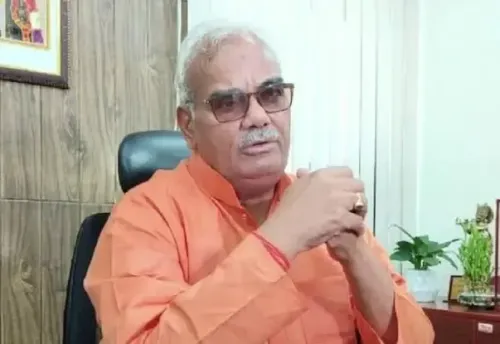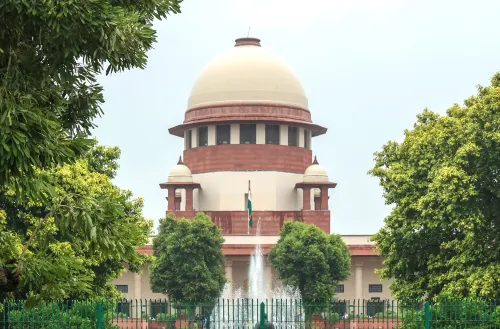Maha: Ajit Pawar to Unveil First MahaYuti Government Budget Amid Financial Challenges

Synopsis
Key Takeaways
- Ajit Pawar to present Maharashtra's first MahaYuti budget.
- Budget faces challenges of rising public debt and fiscal deficits.
- 30% spending cuts initiated ahead of budget presentation.
- Ambitious target of a $1 trillion economy by 2027-28.
- Focus on increasing revenue and curbing tax evasion.
Mumbai, March 9 (NationPress) Amid financial constraints to maintain freebies while also pursuing capital expenditures in light of escalating public debt and fiscal deficits, Maharashtra's Deputy Chief Minister and Finance and Planning Minister Ajit Pawar is set to unveil the state budget for the fiscal year 2025-26 on Monday.
This budget marks the inaugural financial plan of the newly-elected MahaYuti government, yet it will be Ajit Pawar's eleventh budget as Finance Minister. He will become the second Finance Minister following Sheshrao Wankhede (who presented a record 13 times) to deliver the state budget over ten occasions, albeit not necessarily in succession. Former Finance Minister Jayant Patil delivered the budget ten times, while Sushilkumar Shinde did so nine times.
Ajit Pawar confronts a significant challenge in reconciling the disparity between receipts and expenditures while emphasizing the need for financial discipline to meet the state's ambitious goal of achieving a $1 trillion economy by 2027-28.
Leading up to the budget presentation for 2025-26, the state government has initiated a 30 percent reduction in revenue and capital expenditures across various departments.
The state finance department has projected that the fiscal deficit has surpassed Rs 2 lakh crore, exceeding the budget estimate of Rs 1.10 lakh crore by the close of 2024-25, largely due to a series of welfare and development schemes totaling Rs 96,000 crore, including the Ladki Bahin Yojana launched last July.
Experts suggest that the fiscal deficit could widen to 4.8 percent of the gross state domestic product (GSDP), significantly above earlier projections of 2.6 percent if the government continues its various welfare and development initiatives. The fiscal deficit is expected to decrease to 2.3 percent of GSDP by 2026-27, with populist schemes accounting for 2.2 percent of GSDP and 19 percent of revenue receipts.
A state finance department officer noted that with committed expenditures (salaries, pensions, and interest payments) already consuming 55 percent of revenue, only 26 percent remains available for discretionary spending, including capital expenditures. Despite being India’s largest state by economic size, Maharashtra's capital expenditure-to-GSDP ratio has averaged only 1.5 percent from fiscal 2019 to 2024, ranking 16th out of 19 large states.
The government has allocated a revenue deficit of Rs 20,500 crore, which is 0.5 percent of GSDP for FY25. Additional funds earmarked for women welfare schemes include Rs 25,000 crore for the Majhi Ladki Bahin Yojana, Rs 6,056 crore for skill development, Rs 4,317 crore for social justice, Rs 4,185 crore for public health, and allocations for other welfare initiatives, which will result in a revenue deficit of 1.3 percent of GSDP in FY25.
The government faces a crucial test in delivering on its electoral promise to increase monthly assistance to Rs 2,100 from Rs 1,500 for women beneficiaries under the Ladki Bahin Yojana.
“This adjustment is expected to elevate the budget allocation by 40 percent, from Rs 46,000 crore (1.1 percent of GSDP) to Rs 64,400 crore (1.5 percent of GSDP),” sources from the finance department stated.
Another challenge confronting the government is the rapidly escalating public debt, despite the proposal to sustain tax revenue at 11.70 percent of GSDP for 2024-25, 2025-26, and 2026-27. The total debt stock, which was Rs 7.11 lakh crore in 2023-24, is anticipated to rise to Rs 7.82 lakh crore in 2024-25, reflecting 17.59 percent and 18.35 percent respectively.
The government estimates total debt to reach 18.61 percent and 18.91 percent in 2025-26 and 2026-27, respectively, as it focuses on generating productive assets. However, officials assert that total debt will remain within the permissible limit of 25 percent of GSDP.
Interestingly, NITI Aayog, in its report on the Fiscal Health Index published in January, has warned the Maharashtra government about the surge in debt. “Debt has escalated at an average rate of 9.92 percent annually from 2018-19 to 2022-23. Most of the borrowing has been allocated to repay older debts in the current cycle. While the Debt to GSDP ratio slightly decreased to 18.1 percent this year from 19.3 percent in 2021-22, it was 17.27 percent in 2018-19. The ratio of interest payments to revenue receipts has also diminished from 12.2 percent in 2018-19 to 10.3 percent in 2022-23,” the report states.
Sources from the finance department indicated that Ajit Pawar is expected to outline the government's strategy to enhance its own tax and non-tax revenues by addressing loopholes and minimizing tax evasion in his budget presentation. He will also present a blueprint aimed at restoring Maharashtra's status as a revenue surplus state. Furthermore, Ajit Pawar is anticipated to unveil an action plan to achieve a higher growth rate for the state economy compared to the national economy. The Medium Term Fiscal Policy Statement has explicitly indicated that successful implementation will propel the state's economy to $1 trillion by 2028 and $3.5 trillion by the nation’s centennial year.
(Sanjay Jog can be reached at sanjay.j@ians.in)










